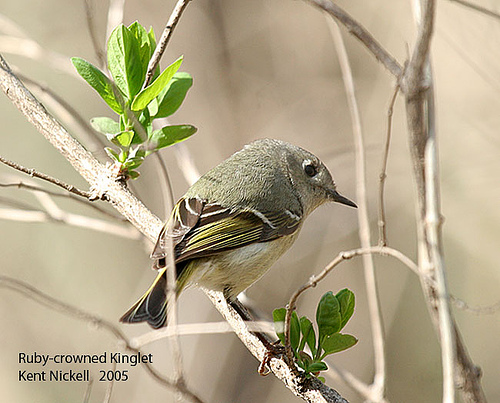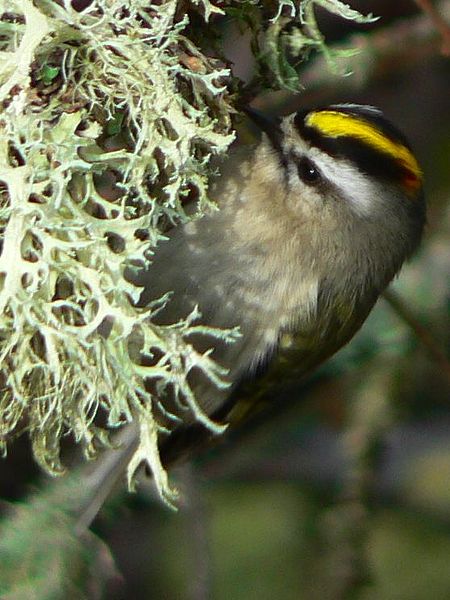Blessed is the man who endures temptation; for when he has been approved, he will receive the crown of life which the Lord has promised to those who love Him. (James 1:12 NKJV)
Goldcrests and Kinglets – Regulidae Family
The Regulidae Family is in the Passeriformes Order (Songbirds). The kinglets or crests are a small group of birds sometimes included in the Old World warblers, but are frequently given family status because they also resemble the titmice. The scientific name Regulidae is derived from the Latin word regulus for “petty king” or prince, and comes from the coloured crowns of adult birds. This family has representatives in North America and Eurasia. There are seven species in this family; one, the Madeira Firecrest, Regulus madeirensis, was only recently split from Firecrest as a separate species. One species, the Ruby-crowned Kinglet, differs sufficiently in its voice and plumage to occasionally be afforded its own genus, Corthylio.
The Latin name regulus means “little king“. It is connected with a fable of the election of the “king of birds“. The bird who could fly the longest distance would be made king. The eagle outflew all other birds, but he was beaten by a small bird who had hidden itself in his plumage. This legend is already known to Aristotle (Hist. animalium 9.11) and Plinius (Naturalis hist. 10.74). The motivation of the name is the yellow “crown” of regulus. Because of the legend’s reference to the “smallest of birds” becoming king, the title was however also transferred to the true wren in some languages.[1] The firecrest and goldcrest are also commonly known as “fire-crested wren” and “golden-crested wren”, respectively, reinforcing the association of the kinglet with the (true) wren. The English name kinglet is a 19th century translation of the Latin name.
And He has on His robe and on His thigh a name written: KING OF KINGS AND LORD OF LORDS. (Revelation 19:16 NKJV)
Kinglets range in size from 9 to 11 cm and are amongst the smallest of the passerines, and indeed of all birds. They have medium-sized wings and tails, and the tails of all species are incised at the tip. The bill is small and needle-like. The plumage is overall grey-green. Most have an eye-ring or a stripe at the supercilium, although the slightly atypical Ruby-crowned Kinglet lacks this. The males possess a colourful crown patch. They have one specific feather which projects forward over the nares (again lacking in the Ruby-crowned Kinglet).
Generally kinglets prefer conifer forests, although there is a certain amount of adaptability and most species will use other habitats, particularly during migration. They have a distribution that takes in the northern boreal forests, but also extend down as far as the subtropics in places. A number of insular populations have evolved into separate species and subspecies.
The tiny size and rapid metabolism of kinglets means that they must constantly forage in order to provide their energy needs. They will continue feeding even when nest building. Kinglets prevented from feeding may lose a third of their body weight in twenty minutes and may starve to death in an hour. Kinglets are insectivores, preferentially feeding on insects such as aphids and springtails that have soft cuticles. Prey is generally gleaned from the branches and leaves of trees, although in some circumstances prey may be taken on the wing or from the leaf litter on the ground.
The nest are small, very neat cups, almost spherical in shape, made of moss and lichen held together with spiderwebs and hung from twigs near the end of a high branch of a conifer. They are lined with hair and feathers, and a few feathers are placed over the opening. These characteristics provide good insulation against the cold environment. The female lays 7 to 12 eggs, which are white or pale buff, some having fine dark brown spots. Because the nest is small, they are stacked in layers. The female incubates; she pushes her legs (which are well supplied with blood vessels, hence warm) down among the eggs. The eggs hatch after 15 to 17 days. The young stay in the nest for 19 to 24 days. After being fed, nestlings make their way down to the bottom of the nest, pushing their still-hungry siblings up to be fed in their turn (but also to be cold).
Their song, especially the Ruby-throated is “remarkably full and loud.”
Ruby-crowned Kinglet call by Chris Parrish and Firecrest call by Stuart Fisher
Tenerife Goldcrest or Orangecrest, Regulus teneriffae, split from Goldcrest as separate species – in western Canary Islands. (Currently they are part of the Goldcrest Regulus regulus. IOC 2.4)
Birds of the World – Regulidae Family
*



Very. Cool write up. Learned a lot about these wonderful, tiny creatures.
LikeLiked by 1 person